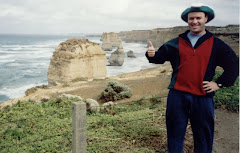Joke of the Week
Good Manners
"Suppose, by mistake, you step on a lady's foot. What do you do?"
"I say pardon me."
"Very good. Now suppose the lady, to reward you, gives you a coin. What do you do?"
"Step on the other foot to get a second one."
Neste site você encontrará diversos materiais para estudar inglês de graça por conta própria. Se você quiser fazer aulas particulares de INGLÊS ou ESPANHOL, entre em contato por e-mail (edunedel@gmail.com).
Infinitive | Simple Past | Past Participle | Translation |
arise | arose | arisen | surgir |
awake | awoke | awoken | despertar |
be | was/were | been | ser, estar |
bear | bore | born | dar a luz |
beat | beat | beaten | bater |
become | became | become | tornar-se |
begin | began | begun | começar |
bite | bit | bitten | morder |
blow | blew | blown | soprar |
bring | brought | brought | trazer |
catch | caught | caught | pegar, capturar |
choose | chose | chosen | escolher |
come | came | come | vir |
cost | cost | cost | custar |
cut | cut | cut | cortar |
do | did | done | fazer |
draw | drew | drawn | desenhar |
dream | dreamt | dreamt | sonhar |
drink | drank | drunk | beber |
drive | drove | driven | dirigir |
eat | ate | eaten | comer |
fall | fell | fallen | cair |
feel | felt | felt | sentir |
fight | fought | fought | luta |
fly | flew | flown | voar |
forbid | forbade | forbidden | proibir |
forgive | forgave | forgiven | perdoar |
get | got | gotten | obter |
give | gave | given | dar |
grow | grew | grown | crescer |
hang | hung | hung | pendurar |
have | had | had | ter |
hear | heard | heard | ouvir |
hide | hid | hidden | esconder |
hit | hit | hit | bater |
hold | held | held | segurar |
hurt | hurt | hurt | machucar |
keep | kept | kept | manter |
know | knew | known | saber, conhecer |
lay | laid | laid | colocar, depositar |
lead | led | led | conduzir, levar |
learn | learnt | learnt | aprender |
leave | left | left | partir |
lend | lent | lent | emprestar |
let | let | let | permitir, deixar |
lie | lay | lain | repousar |
light | lit | lit | acender, clarear |
lose | lost | lost | perder |
make | made | made | fazer |
mean | meant | meant | querer dizer |
meet | met | met | encontrar |
pay | paid | paid | pagar |
put | put | put | pôr, colocar |
read | read | read | ler |
ride | rode | ridden | andar de |
ring | rang | rung | tocar, soar |
rise | rose | risen | erquer-se |
run | ran | run | correr |
say | said | said | dizer |
see | saw | seen | ver |
seek | sought | sought | procurar |
sell | sold | sold | vender |
send | sent | sent | enviar |
shake | shook | shaken | sacudir |
shine | shone | shone | brilhar |
shoot | shot | shot | atirar (com um arma) |
show | showed | shown | mostrar |
shut | shut | shut | fechar |
sing | sang | sung | cantar |
sink | sank | sunk | afundar |
sit | sat | sat | sentar |
sleep | slept | slept | dormir |
smell | smelled | smelled | cheirar |
speak | spoke | spoken | falar |
spend | spent | spent | gastar |
stand | stood | stood | permanecer |
steal | stole | stolen | roubar |
sting | stung | stung | picar, ferroar |
stink | stank | stunk | cheirar mal |
strike | struck | stricken | golpear |
sweep | swept | swept | varrer |
swim | swam | swum | nadar |
take | took | taken | pegar, tomar |
teach | taught | taught | ensinar |
tear | tore | torn | rasgar |
tell | told | told | dizer, contar |
think | thought | thought | pensar, achar |
throw | threw | thrown | atirar, jogar |
understand | understood | understood | compreender |
wake | woke | woken | acordar |
wear | wore | worn | usar |
wed | wed | wed | casar |
weep | wept | wept | chorar |
win | won | won | vencer |
write | wrote | written | escrever |






